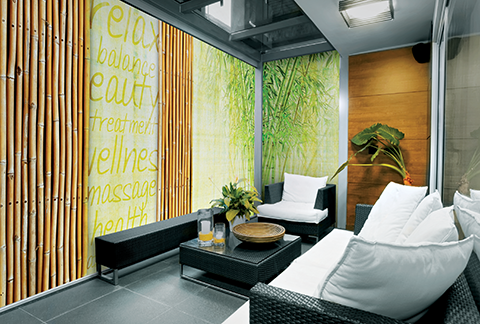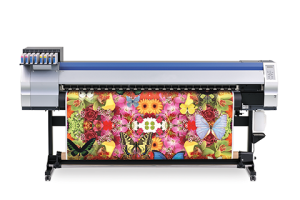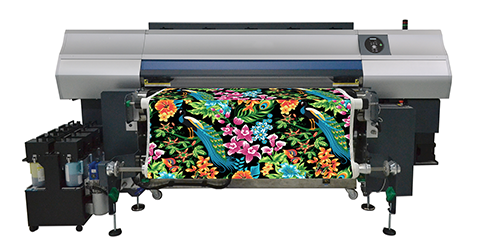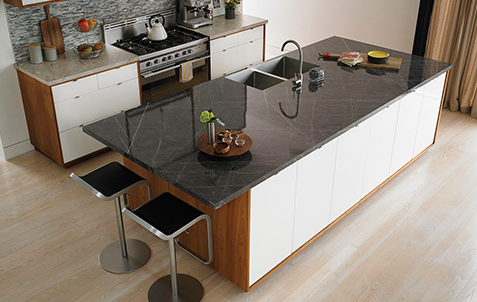Wide-format Graphics: Inkjet printing interior décor
by all | 20 March 2015 9:21 am
 [1]
[1]Photo courtesy HP Canada
By Peter Saunders
In November 2014, the European Specialist Printing Manufacturers Association (ESMA) organized the first-ever Printed Interior Decoration (PID) conference in Düsseldorf, Germany. The event reflected a growing interest in using digital inkjet printers to create wallpaper, room partitions and other interior décor applications.
The conference highlighted how the interior design and construction industries have their own standards and regulations that govern the nature of such graphics—including rules about washability, colourfastness, indoor air quality (IAQ) and flame retardancy—but suggested existing technology already allows print-service providers (PSPs) to become full contractors in the supply of décor applications.
“With a little help and expertise, many large-format PSPs can become important suppliers of interior decoration,” says Peter Buttiens, ESMA’s CEO and PID’s event organizer. “The décor sector could become as lucrative for them as the display and banner market is today. They have the equipment, but need further knowledge and new customers and professional partners.”
Buttiens promised the next PID, scheduled for November 2016, will feature a broader scope with designers, suppliers, PSPs and creative developers.
Customization and regulations
In recent years, concurrent developments in design software and digital printing technology have made it easier to customize indoor environments with short-run and one-off wallpaper, drapery, upholstery, window graphics, rugs, lampshades and pillows, among other décor applications. Original patterns and photos can be printed onto a growing number of suitable substrates for long-term indoor use.
 [2]
[2]Dye-sublimation printers designed for apparel applications that require image transfer onto polyester-based textiles can also be used for soft signage and some interior décor applications. Photo courtesy Mimaki
“There used to be no way to do short-run customization,” says Kevin Sykes, general manager (GM) of sign, display and inkjet press solutions for HP Canada. “Today, you can sit in an office and create surfaces with any design, at any size, with millions of colours, including skin tones that were traditionally difficult but can now be recreated in detail.”
These tools have been adopted by a wide variety of professionals, from wallcovering manufacturers creating their own proprietary-design collections to small print shops specializing in textile graphics, but they are also rooted squarely within the sign industry.
“Digitally printed wallcoverings and other textile-based applications have followed in the wake of soft signage, which became popular in the European market because of strict environmental laws,” says Carlo Toscano, president of Global Printing in Mississauga, Ont. “We’ve been to the Federation of European Screen Printers Associations (FESPA) show and what’s happening in North America is a repeat of Europe. Everyone is asking for printed textiles. They don’t want polyvinyl chloride (PVC) anymore.”
Global Printing is best-known for producing signs, banners and displays, but Toscano says interior décor applications have offered significant growth since the company recently began using durable aqueous ‘latex’ inkjet printers.
“We installed our first latex machine five years ago,” he says. “Right away, it increased our output. It cut our turnaround time by half. We have installed four since then and will continue to add more. We’re getting customer requests across the board from every sector, from banks to event organizers.”
A market for everyone
Levey Industries in Oakville, Ont., never used to be a printing company, but as an established provider of wallcoverings, upholstery, seating and other décor, it
too has turned to latex inkjet printing.
“Now that you can print on PVC-free films, graphics are being wrapped onto tables, benches and walls,” says Monika Lal, marketing and communications specialist for HP Canada. “The latex inks are also Greenguard-certified for indoor use, such as at hospitals and schools.”
Another non-traditional example is Formica Group, which has manufactured laminates for more than 100 years and has offices in Saint-Jean-sur-Richelieu, Que. Today, Formica prints patterned graphics on its high-pressure laminates, which then become the surfaces of doors, reception desks, wall panels and other décor.
“We capture granite, stone and wood patterns for a lifelike, durable surface,” Annie Fournier, regional marketing manager. “We take a digital photo of the selected slab of granite, stone or wood and process it on a laminate at actual size. This way, we can offer laminates in a wide variety of colour and pattern options for residential and commercial clients.”
 [3]
[3]Advances in design software and digital printing have made it feasible to customize short-run and even one-off wallcoverings for large spaces. Photo courtesy HP Canada
Homeowners use Formica’s printed laminates for countertops, backsplashes, cabinets and islands in kitchens, laundry rooms, bathrooms and mudrooms. Commercial clients use them in offices as partitions and stores as retail fixtures, among other applications.
“We partnered with well-known interior designer Jonathan Adler to launch one of our new collections,” says Fournier. “We are also seeing the desire for custom design. We can take designs, photography, logos, illustrations or paintings and create custom laminates for commercial clients. Any space can become more individual. The possibilities are really endless. If we can imagine it, we can make it.”
Fortunately, there is plenty of room in these markets for PSPs and sign companies to work with established interior décor businesses, rather than against them in heated competition.
“We network with wallcovering companies so we can offer their customers something completely different,” says Global Printing’s Toscano. “Interior designers also bring us into their client meetings. It’s been a big shift. The main challenge is educating clients about what’s possible.”
Ink options
One of the other challenges is choosing an ink technology. Toscano cites his own reasons for choosing latex over
dye sublimation.
“Dye sub achieves excellent results, but is a very long process,” says Toscano. “We looked at our own production cycle, where we’re creating textile graphics for more than 200 events per year, and realized we had to go with latex.”
Ken VanHorn, director of marketing and business development for wide-format inkjet printer manufacturer Mimaki, speaks to the benefits of dye sub.
“For most indoor applications, it’s really the way to go,” he says. “With a grand-format printer, you can do everything from wallcoverings and shower curtains to pillows and upholstery to bed sheets and ceiling tiles. And the process is getting easier as inks are better-integrated with printers. Before, you had to buy inks and printers from different companies and put them all together yourself, with no warranty. There’s still some ‘mystique’ to dye sub and a need for education, but it’s not hard.”
That said, VanHorn also sees a role for latex and ultraviolet-curable (UV-curable) inks, particularly in wallcoverings.
 [4]
[4]Some printers use a ‘sticky belt’ drive system to ensure stable handling of fabrics that have a tendency to stretch. Photo courtesy Mimaki
“A variety of technologies can serve the interior décor market, depending which you have at your disposal, and that’s the exciting part,” he says. “As quality standards are evolving, it’s still like the ‘wild west’ out there.”
Windows of opportunity
Key developments in new materials have also helped foster growth in customizable interior décor. There has been rich experimentation in window films, for example, that can be applied to room partitions and other architectural elements.
“There are different kinds of window films for solar control, safety, privacy, graphics and other purposes,” says Peter Yates, owner and president of Window Film Systems (WFS) in London, Ont. “While we’ve always distributed films that could be printed on, in the past those with a scratch-resistant coating could not receive inks. That changed around 2002, when manufacturers started providing clear, scratch-resistant polyester films that could be printed with graphics.”
Yates explains these films tend to be printed with UV-curable inks, but latex is also starting to have an impact on the market.
 [5]
[5]Formica Group prints patterned graphics on laminates for interior décor surfaces. Photo courtesy Formica Group
“A lack of solvents is definitely a selling feature for interior décor,” he says. “Also, optical clarity carries a high value for these applications. That can’t be achieved with vinyl; you need polyester.”
Like Formica Group’s laminates, WFS also offers preprinted patterns like wood grains and marble finishes.
“A lot of people are interested in these patterns for walls and ceilings, not just glass surfaces,” says Yates. “While the majority of our work is still in window films, we’re also covering reception desks and other furniture.”
As such, Yates highlights the potential of converting interior surfaces throughout an entire office building, compared to simply providing a few high-impact window graphics.
“Interior design is big business, but it’s a very different world from signage,” he says. “You need a slower-sell approach. We have a graphic designer on staff who helps architects implement these kinds of jobs. You have to become a design shop, not just a production shop.”
With files from ESMA, HP Canada, Global Printing, Formica Group, Mimaki and WFS. For more information, visit www.esma.com, www.hp.com, www.globalprinting.ca, www.formica.com, www.mimakiusa.com and www.windowfilmsystems.com.
- [Image]: http://www.signmedia.ca/wp-content/uploads/2015/03/Spa_Wallcovering.png
- [Image]: http://www.signmedia.ca/wp-content/uploads/2015/03/Mimaki_TS34-1800A_5x3.png
- [Image]: http://www.signmedia.ca/wp-content/uploads/2015/03/Hotel_lobby2.png
- [Image]: http://www.signmedia.ca/wp-content/uploads/2015/03/Mimaki_Tx500-1800B_6x3.png
- [Image]: http://www.signmedia.ca/wp-content/uploads/2015/03/15_180fx_Ferro-Graphite_9483_2sm.png
Source URL: https://www.signmedia.ca/wide-format-graphics-inkjet-printing-interior-decor/